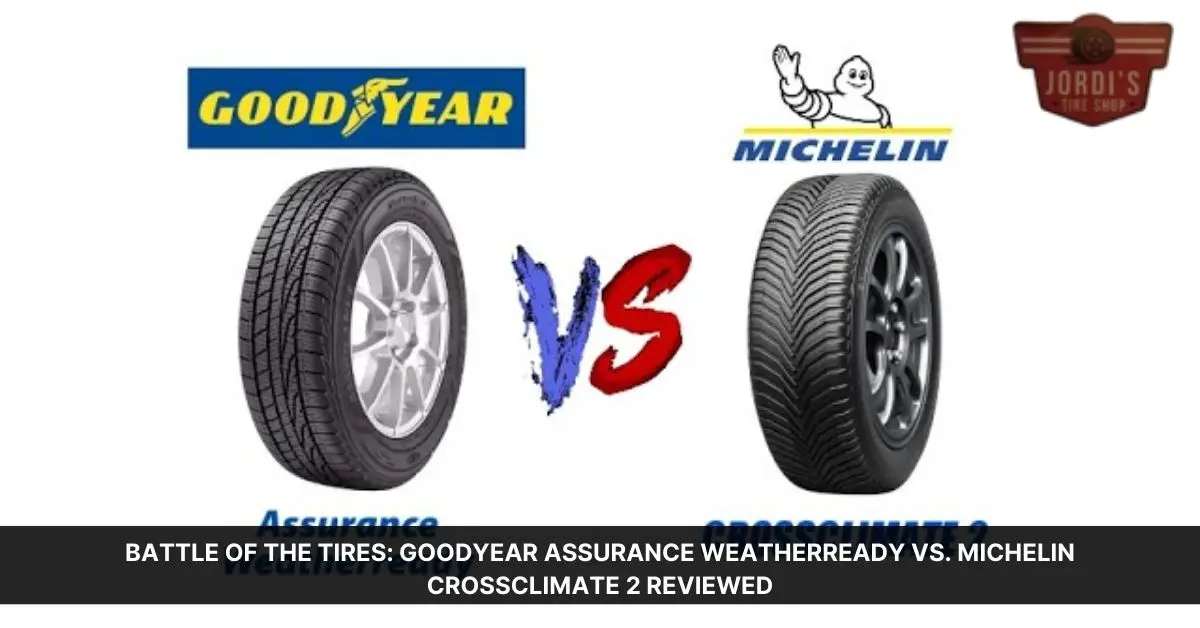In the industry of tires, two names often rise to the top: Goodyear and Michelin. But when it comes down to the Assurance WeatherReady and the CrossClimate 2, which one takes the lead?
Imagine cruising on a rainy day, confident that your tires have you covered. Or picture a snowy morning, where you’re not fretting about the drive because you trust your tire’s grip. That’s the peace of mind the right tire can offer.
We’re diving deep into the features, performance, and overall value of these two popular tires. So, if you’re on the fence about your next tire purchase, you’re in the right place. Buckle up as we compare Goodyear’s Assurance WeatherReady and Michelin’s CrossClimate 2.
Understanding the Basics: Goodyear Assurance WeatherReady vs Michelin CrossClimate 2
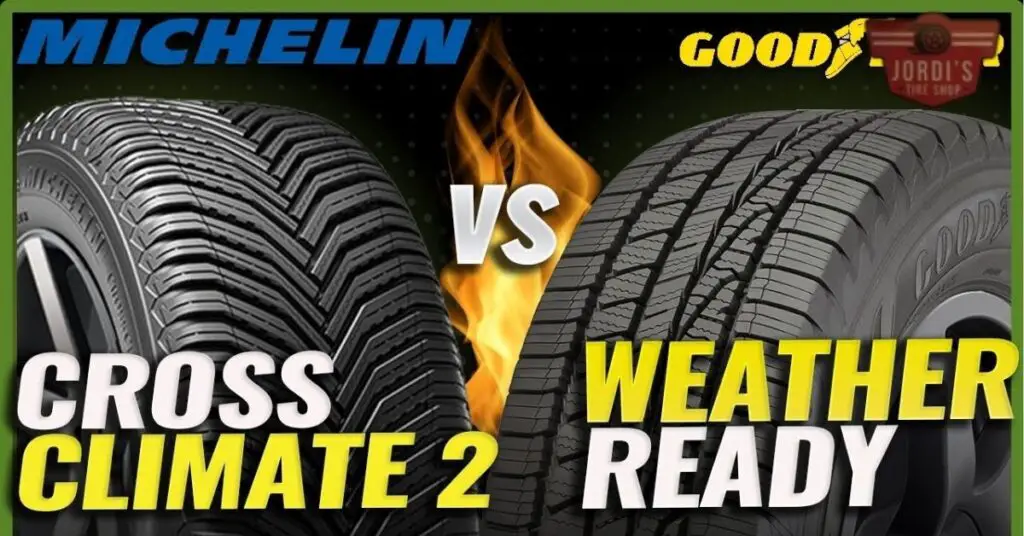
Drilling down into the specifics, we’ll consider two prime tire models – Goodyear’s Assurance WeatherReady and Michelin’s CrossClimate 2.
A Quick Overview About Goodyear Assurance WeatherReady
Primarily, the Goodyear Assurance WeatherReady is a marvel of modern tire technology. It’s designed to optimize traction, whatever the weather. With its Evolving Traction Grooves and Weather Reactive Technology, the Assurance WeatherReady is adaptable. The tread pattern changes as the tire wears, improving grip, particularly in the rain, when you’d typically face most challenges. Besides, the tire includes a special Soy-based rubber compound, making it both flexible in cold conditions and robust in the high heat. Betwixt all these features, dry, wet, or snowy, this tire doesn’t falter. It’s a striking model of Goodyear’s resilience to the elements.
A Quick Overview About Michelin CrossClimate 2
On the other hand, the Michelin CrossClimate 2 represents an apex of versatility and longevity. With its V-Formation tread pattern and Emerging Grooves technology, this tire evolves, similar to the Assurance WeatherReady. Tread grooves emerge as the tire wears down, maintaining wet-weather traction. An additional feature is the Self-locking 3D Sipe technology. This design allows the CrossClimate 2 to enhance traction on snowy roads, thereby conquering any winter worries. Also, the tire shines with its premium touchstones – increased tread life and better fuel efficiency. Amid these advantages, the CrossClimate 2 symbolizes Michelin’s innovation and performance commitment.
Delving into the Key Features
The design nuances and tech advancements make both tires – Goodyear’s Assurance WeatherReady and Michelin’s CrossClimate 2 – unique in their own ways. In this section, we investigate deeper into the specifics that characterize these two models.
Key Features of the Goodyear Assurance WeatherReady
Goodyear Assurance WeatherReady, a superior innovation by Goodyear, boasts a range of distinctive features. Firstly, the Evolving Traction Grooves optimize tread patterns, aiding your car’s grip across various weather conditions. This integrated technology provides enhanced handling throughout the tire’s life.
Another standout feature, Weather Reactive Technology, allows the tire to adapt to the changes in road conditions. It reacts correspondingly, so ensuring flexibility and security.
The Assurance WeatherReady also adopts an exceptional soy-based rubber compound. This compound not only provides flexibility in cold weather but also ensures durability in excessive heat, testifying to the tire’s robust built.
Key Features of the Michelin CrossClimate 2
Next, let’s investigate into the Michelin CrossClimate 2, a testament to Michelin’s commitment toward innovation and performance. One of its key features is the V-Formation tread pattern. This enables superior traction, making it a reliable option for confronting wet, snowy roads.
Notably, the tire incorporates Self-locking 3D Sipe Technology. These sipes lock together when tire tread blocks come in contact with the road surface boosting traction, increasing grip, and giving the driver excellent control over the vehicle.
Also, the CrossClimate 2 also shines in terms of longevity and fuel efficiency. An extended tread life coupled with improved gas mileage, make it an ideal choice for those looking for sustainable and cost-effective tire options.
Performance Comparison: Goodyear Vs Michelin
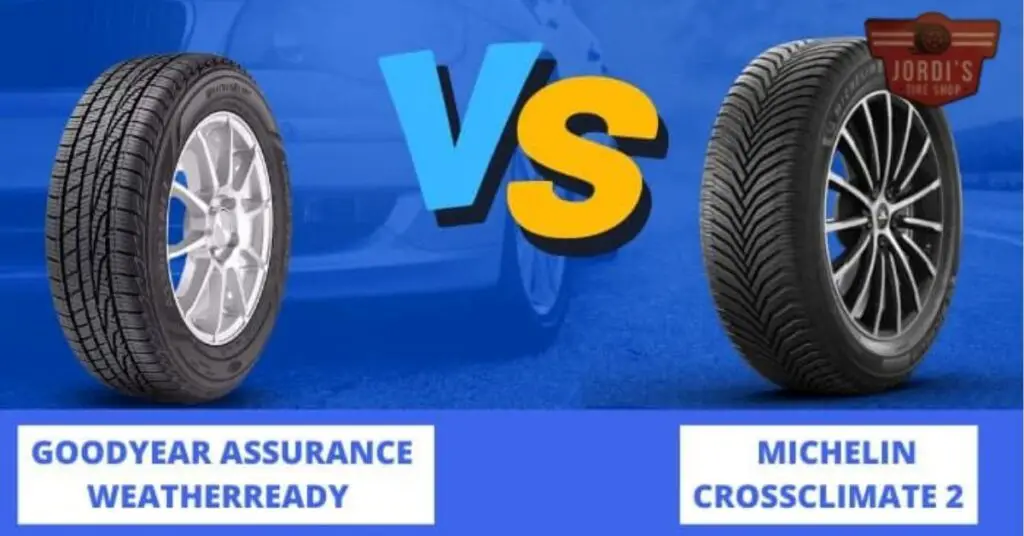
Comparing the performance aspects of Goodyear’s Assurance WeatherReady and Michelin’s CrossClimate 2, let’s investigate into the specifics of handling, comfort, noise level, and fuel efficiency.
Handling and Grip Comparison
When it comes to handling, Assurance WeatherReady employs Evolving Traction Grooves and Weather Reactive Technology that offer enhanced road grip, irrespective of weather conditions. Even during transitions from dry to wet, icy, or snowy roads, these technologies ensure firm control, optimizing your driving experience. In contrast, Michelin’s CrossClimate 2, with its V-Formation tread pattern and Self-locking 3D Sipe Technology, provides adept traction on wet and snowy surfaces. It’s also designed for superior cornering grip and control, allowing you to confidently navigate through diverse weather conditions or terrains.
Comfort and Noise Level Comparison
Turning to ride comfort and noise level, Goodyear Assurance WeatherReady’s design significantly reduces in-cabin noise, so ensuring a peaceful and comfortable ride. The tire’s smooth transitions between traction grooves help lessen road noise, improving your journey’s comfort. Contrasting this, Michelin CrossClimate 2 employs its distinctive V-Formation tread pattern, which, besides improved grip, also serves to suppress excess road noise. This results in quieter rides, adding comfort to your drives.
Fuel Efficiency Comparison
Finally, the fuel efficiency aspect is crucial when considering the impact on your vehicle’s operating cost. Using a unique soy-based rubber compound, Assurance WeatherReady demonstrates resistance to heat, influencing your car’s fuel efficiency positively. On the other hand, CrossClimate 2, known for its increased tread life, also scores high in fuel saving. Thanks to Michelin’s innovative energy-saving technologies incorporated into its design, driving on CrossClimate 2 tires can contribute to reduced fuel consumption, providing a cost-effective solution for your car’s energy needs.
Pros and Cons: A Side-by-Side Look
Trying to choose between Goodyear’s Assurance WeatherReady and Michelin’s CrossClimate 2? Let’s take a detailed look at the pros and cons of both tire models, each with their unique features and advantages.
Pros and Cons of Goodyear Assurance WeatherReady
The Assurance WeatherReady from Goodyear show off an impressive profile with strengths encompassed by sturdy build and innovative design.
Starting with strengths, it’s Evolving Traction Grooves and Weather Reactive Technology provide exceptional grip under various weather conditions. Its soy-based rubber compound strikes a balance between flexibility in cold weather and durability in heat.
Yet, every tire has its drawbacks. Although designed for maximum performance, its performance on snow-covered roads has received mixed reviews. Some find the tires slipping on icy tracks, showing a potential area of improvement.
Pros and Cons of Michelin CrossClimate 2
Turning our attention to Michelin’s CrossClimate 2, this model also showcases a set of prominent pros matched with some minor cons.
A noteworthy pro, it’s V-Formation tread pattern and Self-locking 3D Sipe technology work together to enhance traction on both wet and snowy roads. If longevity is a concern, rejoice as the extended tread life of this tire is known to stand up to the test of time. Besides, it’s better fuel efficiency recurring reviews remark this as a value-added feature.
Even though these appreciable advantages, there’s an observed setback. Users report that the tires may underperform in extremely hot temperatures, lining it up as a potential area needing addressal.
The Verdict: Making Your Choice
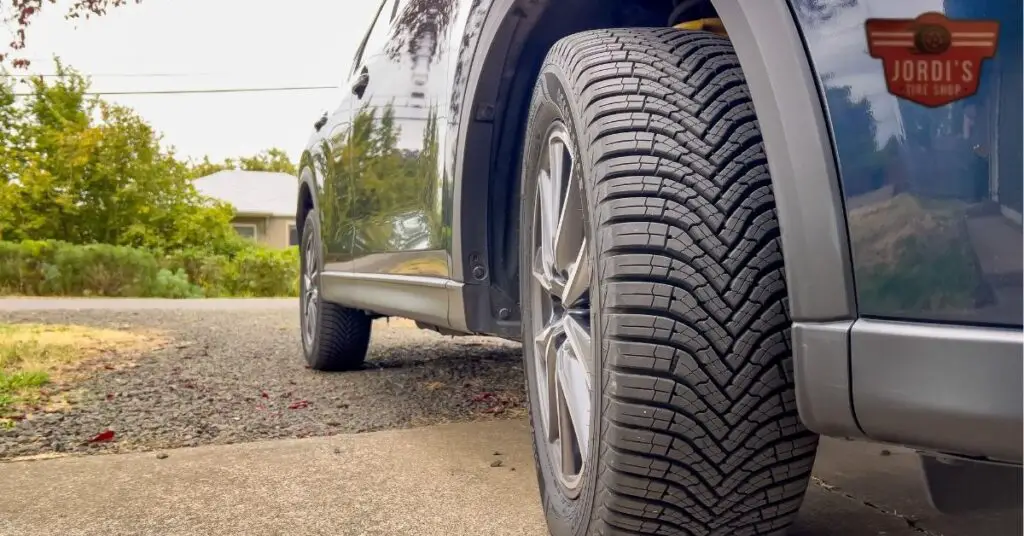
Making a tire purchase boils down to personal preferences and requirements. Both Goodyear’s Assurance WeatherReady and Michelin’s CrossClimate 2 make solid contenders, bringing a host of features and advantages to the table.
Focusing on the Assurance WeatherReady, its proprietary technologies — Evolving Traction Grooves and Weather Reactive Technology — translate into secure handling under varying road conditions. It also stands out with a unique soy-based rubber compound designed for flexibility in cold weather and durability against heat. But, enthusiasts might find the Assurance WeatherReady’s snow performance underwhelming, especially over icy routes.
Turning to the CrossClimate 2 by Michelin, versatility and longevity dominate its value proposition. Its V-Formation tread pattern and Self-locking 3D Sipe technology offer superior grip on wet and snowy roads, making the CrossClimate 2 a reliable companion in inclement weather. Also, its extended tread life and enhanced fuel efficiency align with a sustainable and cost-effective commitment. Nevertheless, performing under scorching temperatures could be a downside that Michelin might address in future iterations of the CrossClimate series.
Eventually, your decision hinges on the exact conditions you frequently drive in, your budget, and the performance aspects you value most in a tire. Weigh the strengths and potential areas of improvement of both models against your own criteria–whether it’s excellent traction in wet conditions, noise reduction, fuel efficiency, or longevity. This approach ensures you choose a tire that meets your demands and contributes to a safe and comfortable driving experience.
User Satisfaction: What Customers Say
Let’s investigate into user reviews and ratings to gain more insight into these tires’ performance from actual users’ perspectives. Using customer testimonials as reliable feedback, we’ll identify what real drivers say about the Goodyear Assurance WeatherReady and the Michelin CrossClimate 2.
Customer Reviews of Goodyear Assurance WeatherReady
Amid user testimonials on Goodyear Assurance WeatherReady, many customers often highlight the tire’s impressive wet and dry traction. Users admire the tire’s performance in rain, applauding its grip and stability on soaked surfaces. One user noted the tire’s ability to “handle heavy downpours with ease,” ensuring a safe and confidence-inspiring ride.
On the flip side, reviews indicate mixed feelings toward winter conditions handling. While some users declare it’s adequate for light to moderate snow, criticism surfaces about icy conditions performance. One disappointed user remarked, “The snow performance in particular was lackluster, especially on icy surfaces.”
As for comfort, a good number of customers express satisfaction with the tire’s quiet operation. Users appreciate the minimized road noise, thereby contributing to a tranquil and comfortable driving experience. One satisfied customer said, “The ride is remarkably quiet, making long-distance journeys much more pleasurable.”
Finally, about durability, buyers appreciate the tire’s resistance to wear and tear. Many customers report that the tires remain intact even after important mileage, indicative of high durability. For example, one customer proudly claims, “Even after 60,000 miles, the tires show minimal signs of wear.”
Customer Reviews of Michelin CrossClimate 2
Among reviews on the Michelin CrossClimate 2, users often rave about the tire’s superb all-season capability. With exceptional praise given for wet weather and snow traversal, customers often express their approval. One pleased driver mentioned, “These tires handle wet and snowy conditions exceptionally well, offering confidence on slippery roads.”
In terms of comfort, drivers note the tire’s quiet and smooth ride, often commending it for the reduction in road noise. One user commended the model saying, “The roads around here can be rough, but these tires smooth it out and keep the cabin quiet.”
When it comes to tread life, a large number of customers appreciate the tire’s long-lasting performance. A user noting, “I am extremely impressed by the longevity of these tires; they still look good after 70,000 miles.”
But, it’s not all positive for the CrossClimate 2. Some customers noted underperformance in extremely hot climate, expressing dissatisfaction with tread wear in such conditions. A user recounted, “In particularly hot weather, the tires seemed to wear down faster than expected.”
Overall, analyzing actual customer opinions provides a unique perspective, allowing for a deeper understanding of each of the two tire models – Goodyear Assurance WeatherReady and Michelin CrossClimate 2.
Price Comparison: Which Gives More Value for Money
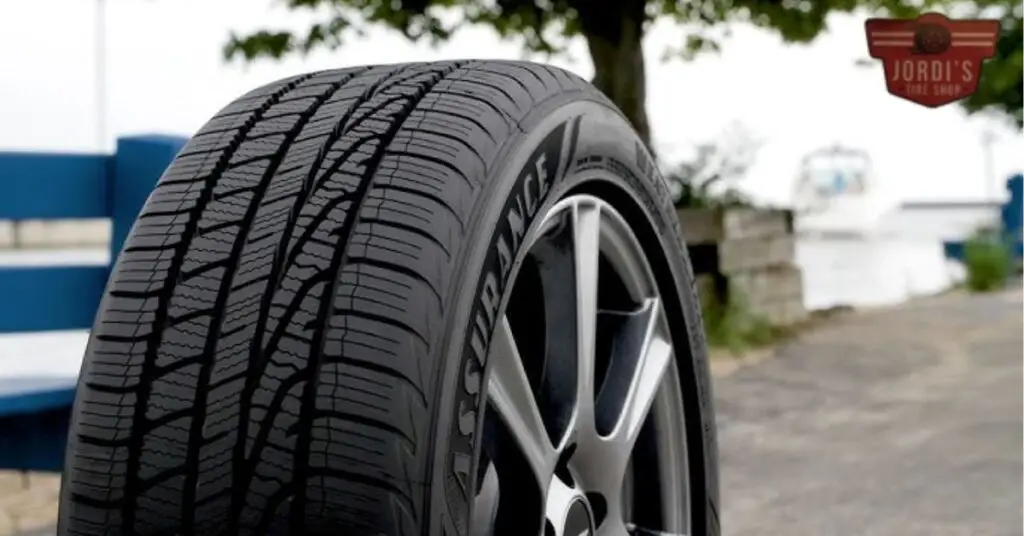
When comparing the Goodyear Assurance WeatherReady to the Michelin CrossClimate 2, it’s crucial to incorporate the price factor. Both tires demonstrate exceptional features and performance attributes, which, in turn, influence their price points.
Looking at Goodyear Assurance WeatherReady first, prices tend to range from $120 to $200 per tire, depending on the tire size needed. Its advanced technologies such as Evolving Traction Grooves and Weather Reactive Technology give it an edge in various weather conditions, ensuring durability and flexibility. This translates into long-lasting use and less frequent changes, eventually saving you money in the long run.
Take a peek at Michelin CrossClimate 2, which comes with a slightly higher price tag, ranging between $150 to $250 per tire. It’s worth noting that this difference in price reflects the V-Formation tread pattern and Self-locking 3D Sipe technology, improving its grip, control, tread life, and offering superior fuel efficiency.
So, when analyzing price versus value, you might find that while Michelin CrossClimate 2 is priced higher, potentially due to its sustainable and cost-effective features, the lower-priced Goodyear Assurance WeatherReady doesn’t fall short, providing reliable performance appeals to many.
To provide a clearer picture, below is a markdown table summarizing the price ranges and notable features of both tire models:
| Tire Model | Average Price Range | Notable Features |
|---|---|---|
| Goodyear Assurance WeatherReady | $120 – $200 | Evolving Traction Grooves, Weather Reactive Technology |
| Michelin CrossClimate 2 | $150 – $250 | V-Formation tread pattern, Self-locking 3D Sipe technology |
In sum, both Goodyear Assurance WeatherReady and Michelin CrossClimate 2 provide excellent value for money, given their unique features and performance capabilities. It’s worthwhile to consider not only the upfront cost but also the long-term value these tires offer – such as less frequent changes and reduced fuel costs. When making the final purchasing decision, keep in mind your exact driving needs and conditions.
Conclusion
Choosing between Goodyear Assurance WeatherReady and Michelin CrossClimate 2 isn’t a one-size-fits-all decision. Your choice hinges on your driving needs and weather conditions. Assurance WeatherReady shines with its innovative tech and excellent handling, yet it’s not the top performer in icy conditions. On the flip side, CrossClimate 2 stands out with its all-season capability and longevity, but might not be the best choice for extremely hot climates. Both offer great value for money, considering their durability and fuel efficiency. So, it’s up to you to decide which tire suits your needs best. Remember, the right tire can significantly enhance your safety and comfort on the road.
What are the unique features of Goodyear’s Assurance WeatherReady tires?
The Goodyear Assurance WeatherReady tires include Evolving Traction Grooves and Weather Reactive Technology, which enhance grip in variant weather conditions. Its distinct soy-based rubber compound is flexible in cold weather and durable in heat.
What special attributes does Michelin’s CrossClimate 2 tires offer?
Michelin’s CrossClimate 2 tires feature a V-Formation tread pattern and Self-locking 3D Sipe technology, that improve traction on wet and snowy roads. These tires are known for their extended tread life and better fuel efficiency.
Which tire model performs better in comfort and noise reduction?
Both tires have good performance in terms of comfort and noise reduction. The Goodyear Assurance WeatherReady reduces in-cabin noise while the Michelin CrossClimate 2 suppresses road noise.
What are the potential shortcomings of both tire models?
Goodyear Assurance WeatherReady may have mixed performance on snow-covered and icy roads. Michelin CrossClimate 2 on the other hand, might underperform in extremely hot temperatures.
How do user reviews rate the performance of both tires?
Users of Goodyear Assurance WeatherReady commend its traction, quiet operation, and durability, with some criticism regarding icy conditions. Michelin CrossClimate 2 users praise its all-season capability, comfort, longevity, but report some tread wear in hot climates.
What is the price comparison between the two tire models?
The Goodyear Assurance WeatherReady is priced between $120 and $200 per tire, while the Michelin CrossClimate 2 ranges from $150 to $250 per tire.
Which tire is the best choice?
The choice depends on personal preferences and driving conditions. The strengths and weaknesses of both models should be weighed against individual driving needs for enhancing safety and comfort.
Related Posts:
- Battle of the Tires: Goodyear Assurance WeatherReady vs. Michelin CrossClimate 2 Reviewed
- Battle of the Titans: Goodyear Wrangler UltraTerrain AT vs BF Goodrich KO2 Explained
- Goodyear Assurance WeatherReady Vs MaxLife: Which Tire Rules the Road?
- Hankook Dynapro AT2 VS Falken Wildpeak AT3W: Unraveling the Best All-Terrain Tire for Your Ride
- Michelin Pilot Sport 4S vs Pirelli P Zero: Your Ultimate Tire Showdown
- V-rated vs H-rated Tires: Uncovering the Speed Ratings for Safer Driving
- Decoding the Dilemma: SL vs C1 Tires – A Comprehensive Guide for Car Owners

